The traditional distribution processes have become obsolete, for this reason, geofences arrived to improve the different services. They are a fundamental element when delivering orders or making trips, to arrive more quickly. They consist of confirming a specific zone or perimeter in a virtual way, delimiting the place from what surrounds it.
They do not have a specific size or shape as they are created by map-tracing software. Thus, each company can draw their fences over the geographical area they need. It can be used for taxi services without any problems, although they tend to be more common in logistics and distribution industries. Since this helps to see if the cars leave the assigned zones or if they are breaking their work hours.
The last mile
We already know then that the software helps define delivery areas to make deliveries more efficiently. This is where last-mile logistics comes in, as it is the final step in the order delivery process. This has been key for e-commerce, since it has a significant impact on reducing company expenses and will mark customer satisfaction.
Studies have been carried out such as that of the Mexican Association of Online Sales, where it was found that 32% of buyers bought influenced by faster deliveries in 2021, while in the previous year, it was only 20%, We can notice how the Efficiency gives us bigger orders. The last mile is recommended for big cities, since you have to choose better routes, without traffic or delays.
This is not a simple process, relevant issues such as efficiency and costs must be considered in the medium and long term. Organizing load levels, so you don't miss a trip with only one package when the vehicle can carry 20 packages to the same area. It's all important because 80% of customers will not buy again from a company that has failed to deliver.
Last mile dimensions that help geofences
Depending on what the company requires, last mile logistics can acquire different dimensions. This will depend on the characteristics of each chain and what the company wants to distribute or carry.
-
B2B production chains, in this case, the last mile would cover the supplies that are part of a larger production. For example, making geofences to bring food to a restaurant or spare parts to a factory. Your business would be serving others.
-
Distribution logistics, here we can include the supply of small stores or take workers to their destinations. You need to mark the perimeter in which they can, for example, take everyone with fast and more efficient routes.
-
In supply chains focused on the final consumer and the B2B retail sector, in this case it includes direct delivery to the customer. It can be a pre-arranged point or at your home, normally in these cases it is an online purchase. These cases are the most complicated in terms of logistics and are handled directly by taxi or delivery companies.
These dimensions can be given because last mile logistics can help geofences, with a couple of blocks or between cities.
Issues that may hinder the last step
Managing this type of delivery or mobilization successfully can be difficult, since it is the journey that presents challenges. Many times they have to do with what is delivered or with the vehicles. In addition to the fact that the appearance of the online market has made the scenario more complex, some of the obstacles that can arise are:
-
There are fewer and fewer postage or package agencies within the same city. For this reason, orders often begin to accumulate from delivery companies or contracted transport.
-
The amount of traffic congests the vast majority of urban centers, so regulations have begun. This has affected the distribution, because now there are schedules for large vehicles to load and unload.
-
Now that the need for consumers to have everything delivered to their doorstep has increased, there have been many changes. Companies have had to find how to get the packages, invest in better presentations and innovation. Taking into account the specific treatment that must be taken with each product.
-
Another difficulty is the variety of destinations, which make it difficult to design the routes. In turn, making it difficult to deliver in the last mile, whether they are offices, homes, mailboxes, click & collect collection points, among others. Consequently, the risks of significant setbacks and delays are multiplying.
It is important to take care of these difficulties, address them separately to achieve successful delivery. Leaning on logistical tools, it can be made easier, but organization and consistency are key to this.
The importance of last mile logistics and its geofences
If the distribution is not correctly planned, there is an increase in the consumption of resources. This gives us a glimpse of why it is necessary to drive the last mile within a business. When working in large cities, or in several cities, it is necessary to reduce the cost of fuel as much as possible, both in terms of money and the environment, which is becoming increasingly important.
Geofence planning has a direct impact on customer satisfaction. Since the failures, delays and complications that occur in the last mile can ruin the entire effort of the company. As consumers we look for excellence, so when it comes to having a transport business, we must offer it.






